Trunk Flexion Monitoring among Warehouse Workers Using a Single Inertial Sensor and the Influence of Different Sampling Durations
Abstract
1. Introduction
2. Materials and Methods
2.1. Participants
2.2. Experimental Protocol
2.3. Trunk Posture Acquisition and Processing
- Class 1: flexion angle = 30°–60°
- Class 2: flexion angle = 60°–90°
- Class 3: flexion angle > 90°
3. Results
4. Discussion
5. Conclusions
Author Contributions
Funding
Acknowledgments
Conflicts of Interest
Appendix A
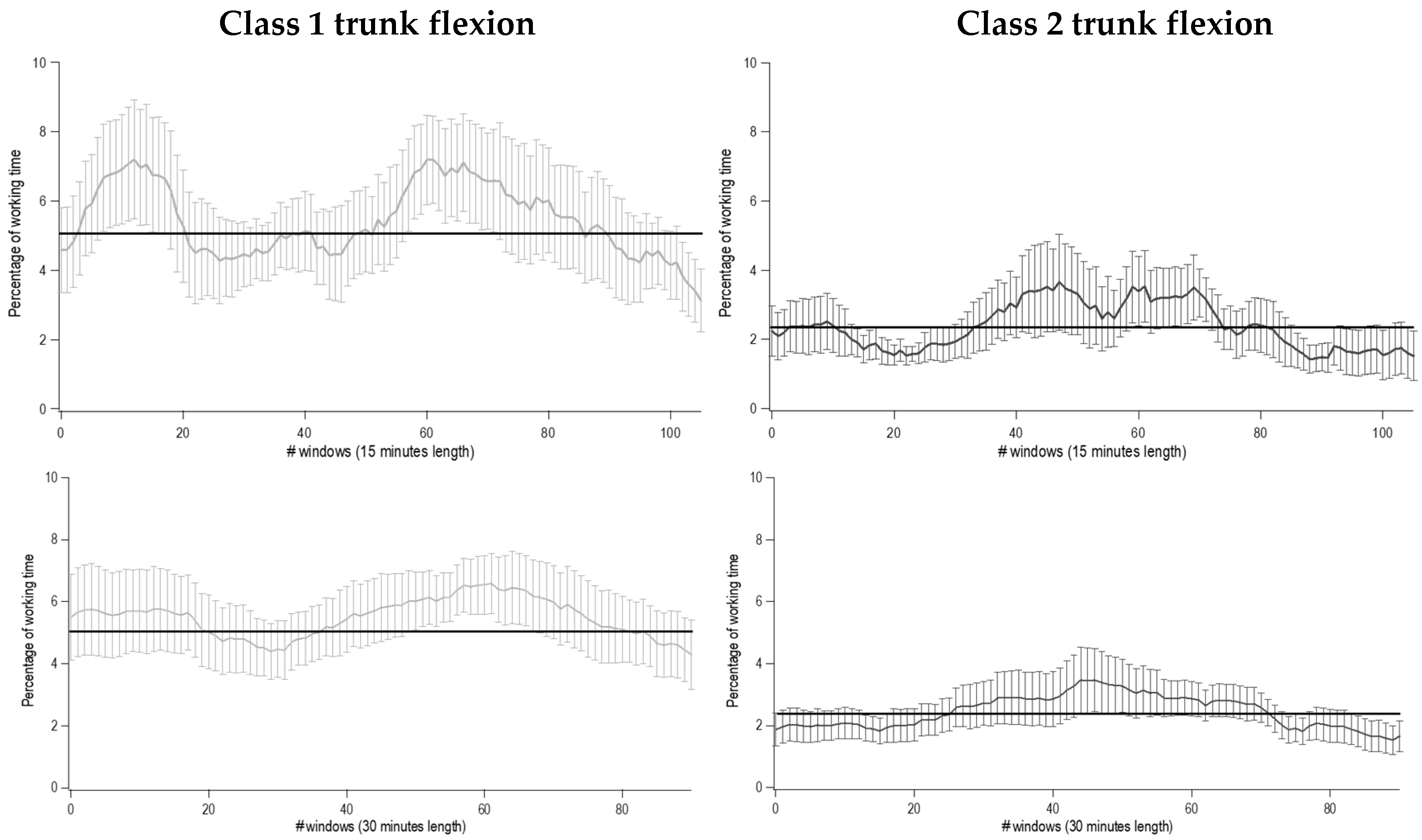

References
- Wai, E.K.; Roffey, D.M.; Bishop, P.; Kwon, B.K.; Dagenais, S. Causal assessment of occupational bending or twisting and low back pain: Results of a systematic review. Spine J. 2010, 10, 76–88. [Google Scholar] [CrossRef] [PubMed]
- Andersen, J.H.; Haahr, J.P.; Frost, P. Risk factors for more severe regional musculoskeletal symptoms: A two-year prospective study of a general working population. Arthritis Rheum. 2007, 56, 1355–1364. [Google Scholar] [CrossRef] [PubMed]
- Da Costa, B.R.; Vieira, E.R. Risk factors for work-related musculoskeletal disorders: A systematic review of recent longitudinal studies. Am. J. Ind. Med. 2009, 53. [Google Scholar] [CrossRef] [PubMed]
- Bernard, B.P. Musculoskeletal Disorders and Workplace Factors. A Critical Review of Epidemiologic Evidence for Work-Related Musculoskeletal Disorders of the Neck, Upper Extremity, and Low Back; U.S. Department of Health and Human Services Public Health Service Centers for Disease Control and Prevention, National Institute for Occupational Safety and Health (NIOSH): Washington, DC, USA, 1997.
- Punnett, L.; Fine, L.J.; Keyserling, W.M.; Herrin, G.D.; Chaffin, D.B. Back disorders and nonneutral trunk postures of automobile assembly workers. Scand. J. Work. Environ. Health 1991, 17, 337–346. [Google Scholar] [CrossRef] [PubMed]
- Villumsen, M.; Samani, A.; Jørgensen, M.B.; Gupta, N.; Madeleine, P.; Holtermann, A. Are forward bending of the trunk and low back pain associated among Danish blue-collar workers? A cross-sectional field study based on objective measures. Ergonomics 2014, 58, 246–258. [Google Scholar] [CrossRef]
- Dunning, K.; Davis, K.G.; Cook, C.; Kotowski, S.E.; Hamrick, C.; Jewell, G.; Lockey, J. Costs by industry and diagnosis among musculoskeletal claims in a state workers compensation system: 1999–2004. Am. J. Ind. Med. 2009, 53, 276–284. [Google Scholar] [CrossRef]
- Burdorf, A.; Van Riel, M. Design of strategies to assess lumbar posture during work. Int. J. Ind. Ergon. 1996, 18, 239–249. [Google Scholar] [CrossRef]
- Heberger, J.; Nasarwanji, M.; Paquet, V.; Pollard, J.P.; Dempsey, P.G. Inter-Rater Reliability of Video-Based Ergonomic Job Analysis for Maintenance Work in Mineral Processing and Coal Preparation Plants. Proc. Hum. Factors Ergon. Soc. Annu. Meet. 2012, 56, 2368–2372. [Google Scholar] [CrossRef]
- Marras, W.; Fathallah, F.; Miller, R.; Davis, S.; Mirka, G. Accuracy of a three-dimensional lumbar motion monitor for recording dynamic trunk motion characteristics. Int. J. Ind. Ergon. 1992, 9, 75–87. [Google Scholar] [CrossRef]
- Williams, R.; Binkley, J.; Bloch, R.; Goldsmith, C.H.; Minuk, T. Reliability of the Modified-Modified Schöber and Double Inclinometer Methods for Measuring Lumbar Flexion and Extension. Phys. Ther. 1993, 73, 26–37. [Google Scholar] [CrossRef]
- David, G. Ergonomic methods for assessing exposure to risk factors for work-related musculoskeletal disorders. Occup. Med. 2005, 55, 190–199. [Google Scholar] [CrossRef] [PubMed]
- Faber, G.S.; Kingma, I.; Bruijn, S.M.; Van Dieën, J.H. Optimal inertial sensor location for ambulatory measurement of trunk inclination. J. Biomech. 2009, 42, 2406–2409. [Google Scholar] [CrossRef] [PubMed]
- Goodvin, C.; Park, E.J.; Huang, K.; Sakaki, K. Development of a real-time three-dimensional spinal motion measurement system for clinical practice. Med. Biol. Eng. 2006, 44, 1061–1075. [Google Scholar] [CrossRef] [PubMed]
- Kim, S.; Nussbaum, M.A. Performance evaluation of a wearable inertial motion capture system for capturing physical exposures during manual material handling tasks. Ergonomics 2013, 56, 314–326. [Google Scholar] [CrossRef]
- Lebel, K.; Boissy, P.; Nguyen, H.P.; Duval, C. Inertial measurement systems for segments and joints kinematics assessment: Towards an understanding of the variations in sensors accuracy. Biomed. Eng. Online 2017, 16, 56. [Google Scholar] [CrossRef]
- Robert-Lachaine, X.; LaRue, C.; Denis, D.; Delisle, A.; Mecheri, H.; Corbeil, P.; Plamondon, A. Feasibility of quantifying the physical exposure of materials handlers in the workplace with magnetic and inertial measurement units. Ergonomics 2019, 63, 283–292. [Google Scholar] [CrossRef]
- Schall, M.C.; Fethke, N.B.; Chen, H.; Oyama, S.; Douphrate, D.I. Accuracy and repeatability of an inertial measurement unit system for field-based occupational studies. Ergonomics 2015, 59, 591–602. [Google Scholar] [CrossRef]
- Faber, G.S.; Chang, C.; Kingma, I.; Dennerlein, J.T.; Van Dieën, J.H. Estimating 3D L5/S1 moments and ground reaction forces during trunk bending using a full-body ambulatory inertial motion capture system. J. Biomech. 2016, 49, 904–912. [Google Scholar] [CrossRef]
- Cutti, A.G.; Giovanardi, A.; Rocchi, L.; Davalli, A.; Sacchetti, R. Ambulatory measurement of shoulder and elbow kinematics through inertial and magnetic sensors. Med. Biol. Eng. 2007, 46, 169–178. [Google Scholar] [CrossRef]
- Godwin, A.; Agnew, M.; Stevenson, J. Accuracy of Inertial Motion Sensors in Static, Quasistatic, and Complex Dynamic Motion. J. Biomech. Eng. 2009, 131, 114501. [Google Scholar] [CrossRef]
- Kim, S.; Nussbaum, M.A. An evaluation of classification algorithms for manual material handling tasks based on data obtained using wearable technologies. Ergonomics 2014, 57, 1040–1051. [Google Scholar] [CrossRef] [PubMed]
- Lim, S.; D’Souza, C. Statistical prediction of load carriage mode and magnitude from inertial sensor derived gait kinematics. Appl. Ergon. 2019, 76, 1–11. [Google Scholar] [CrossRef] [PubMed]
- Yan, X.; Li, H.; Li, A.R.; Zhang, H. Wearable IMU-based real-time motion warning system for construction workers’ musculoskeletal disorders prevention. Autom. Constr. 2017, 74, 2–11. [Google Scholar] [CrossRef]
- Arias, O.E.; Umukoro, P.E.; Stofell, S.; Dennerlein, J.T.; Sorensen, G. Association between Trunk Flexion and Physical Activity in Patient Care Unit Workers. In Proceedings of the Human Factors and Ergonomics Society Annual Meeting; SAGE Publications: Thousand Oaks, CA, USA, 2012; Volume 56, pp. 1188–1191. [Google Scholar]
- Bootsman, R.; Markopoulos, P.; Qi, Q.; Wang, Q.; Timmermans, A.A.; Qi, W. Wearable technology for posture monitoring at the workplace. Int. J. Hum. Comput. Stud. 2019, 132, 99–111. [Google Scholar] [CrossRef]
- Jun, D.; Johnston, V.; McPhail, S.M.; O’Leary, S. Are Measures of Postural Behavior Using Motion Sensors in Seated Office Workers Reliable? Hum. Factors: J. Hum. Factors Ergon. Soc. 2019, 61, 1141–1161. [Google Scholar] [CrossRef]
- Asante, B.O.; Bath, B.; Trask, C.M. Trunk posture assessment during work tasks at a Canadian recycling center. Int. J. Ind. Ergon. 2018, 68, 297–303. [Google Scholar] [CrossRef]
- Balaguier, R.; Madeleine, P.; Rose-Dulcina, K.; Vuillerme, N. Trunk kinematics and low back pain during pruning among vineyard workers—A field study at the Chateau Larose-Trintaudon. PLoS ONE 2017, 12, e0175126. [Google Scholar] [CrossRef]
- Jakobsen, M.D.; Sundstrup, E.; Brandt, M.; Persson, R.; Andersen, L. Estimation of physical workload of the low-back based on exposure variation analysis during a full working day among male blue-collar workers. Cross-sectional workplace study. Appl. Ergon. 2018, 70, 127–133. [Google Scholar] [CrossRef]
- Marras, W.S.; Granata, K.P.; Davis, K.G.; Allread, W.G.; Jorgensen, M.J. Spine loading and probability of low back disorder risk as a function of box location on a pallet. Hum. Factors Ergon. Manuf. 1997, 7, 323–336. [Google Scholar] [CrossRef]
- Marras, W.S.; Granata, K.P.; Davis, K.G.; Allread, W.G.; Jorgensen, M.J. Effects of box features on spine loading during warehouse order selecting. Ergonomics 1999, 42, 980–996. [Google Scholar] [CrossRef]
- Schneider, S.; Lipinski, S.; Schiltenwolf, M. Occupations associated with a high risk of self-reported back pain: Representative outcomes of a back pain prevalence study in the Federal Republic of Germany. Eur. Spine J. 2006, 15, 821–833. [Google Scholar] [CrossRef] [PubMed]
- Beeler, N.; Roos, L.; Delves, S.K.; Veenstra, B.J.; Friedl, K.; Buller, M.J.; Wyss, T. The Wearing Comfort and Acceptability of Ambulatory Physical Activity Monitoring Devices in Soldiers. IISE Trans. Occup. Ergon. Hum. Factors 2018, 6, 1–10. [Google Scholar] [CrossRef]
- Schall, M.C.; Sesek, R.; Cavuoto, L. Barriers to the Adoption of Wearable Sensors in the Workplace: A Survey of Occupational Safety and Health Professionals. Hum. Factors J. Hum. Factors Ergon. Soc. 2018, 60, 351–362. [Google Scholar] [CrossRef] [PubMed]
- Bergmann, J.H.; Chandaria, V.; McGregor, A.H. Wearable and Implantable Sensors: The Patient’s Perspective. Sensors 2012, 12, 16695–16709. [Google Scholar] [CrossRef] [PubMed]
- Cole, G.K.; Nigg, B.M.; Ronsky, J.L.; Yeadon, M.R. Application of the Joint Coordinate System to Three-Dimensional Joint Attitude and Movement Representation: A Standardization Proposal. J. Biomech. Eng. 1993, 115, 344–349. [Google Scholar] [CrossRef]
- Hoogendoorn, W.E.; Bongers, P.M.; De Vet, H.C.W.; Douwes, M.; Koes, B.W.; Miedema, M.C.; Ariëns, G.A.M.; Bouter, L. Flexion and Rotation of the Trunk and Lifting at Work Are Risk Factors for Low Back Pain. Spine 2000, 25, 3087–3092. [Google Scholar] [CrossRef]
- Lowe, B.D. Observation-Based Posture Assessment: Review of Current Practice and Recommendations for Improvement; Department of Health and Human Services Public Health Service Centers for Disease Control and Prevention, National Institute for Occupational Safety and Health (NIOSH): Washington, DC, USA, 2014.
- Mathiassen, S.E.; Winkel, J. Quantifying variation in physical load using exposure-vs-time data. Ergonomics 1991, 34, 1455–1468. [Google Scholar] [CrossRef]
- Jansen, J.P.; Burdorf, A.; Steyerberg, E.W. A novel approach for evaluating level, frequency and duration of lumbar posture simultaneously during work. Scand. J. Work. Environ. Health 2001, 27, 373–380. [Google Scholar] [CrossRef]
- Coenen, P.; Kingma, I.; Boot, C.R.L.; Twisk, J.W.R.; Bongers, P.M.; Van Dieën, J.H. Cumulative Low Back Load at Work as a Risk Factor of Low Back Pain: A Prospective Cohort Study. J. Occup. Rehabil. 2012, 23, 11–18. [Google Scholar] [CrossRef]
- Bayoglu, R.; Galibarov, P.E.; Verdonschot, N.; Koopman, B.; Homminga, J. Twente Spine Model: A thorough investigation of the spinal loads in a complete and coherent musculoskeletal model of the human spine. Med. Eng. Phys. 2019, 68, 35–45. [Google Scholar] [CrossRef]
- Kuorinka, I.; Lortie, M.; Gautreau, M. Manual handling in warehouses: The illusion of correct working postures. Ergonomics 1994, 37, 655–661. [Google Scholar] [CrossRef] [PubMed]
- Authier, M.; Lortie, M.; Gagnon, M. Manual handling techniques: Comparing novices and experts. Int. J. Ind. Ergon. 1996, 17, 419–429. [Google Scholar] [CrossRef]
- Burdorf, A. Sources of variance in exposure to postural load on the back in occupational groups. Scand. J. Work. Environ. Health 1992, 18, 361–367. [Google Scholar] [CrossRef] [PubMed]
- Marras, W.S.; Lavender, S.A.; Leurgans, S.E.; Fathallah, F.A.; Ferguson, S.A.; Allread, W.G.; Rajulu, S.L. Biomechanical risk factors for occupationally related low back disorders. Ergonomics 1995, 38, 377–410. [Google Scholar] [CrossRef]
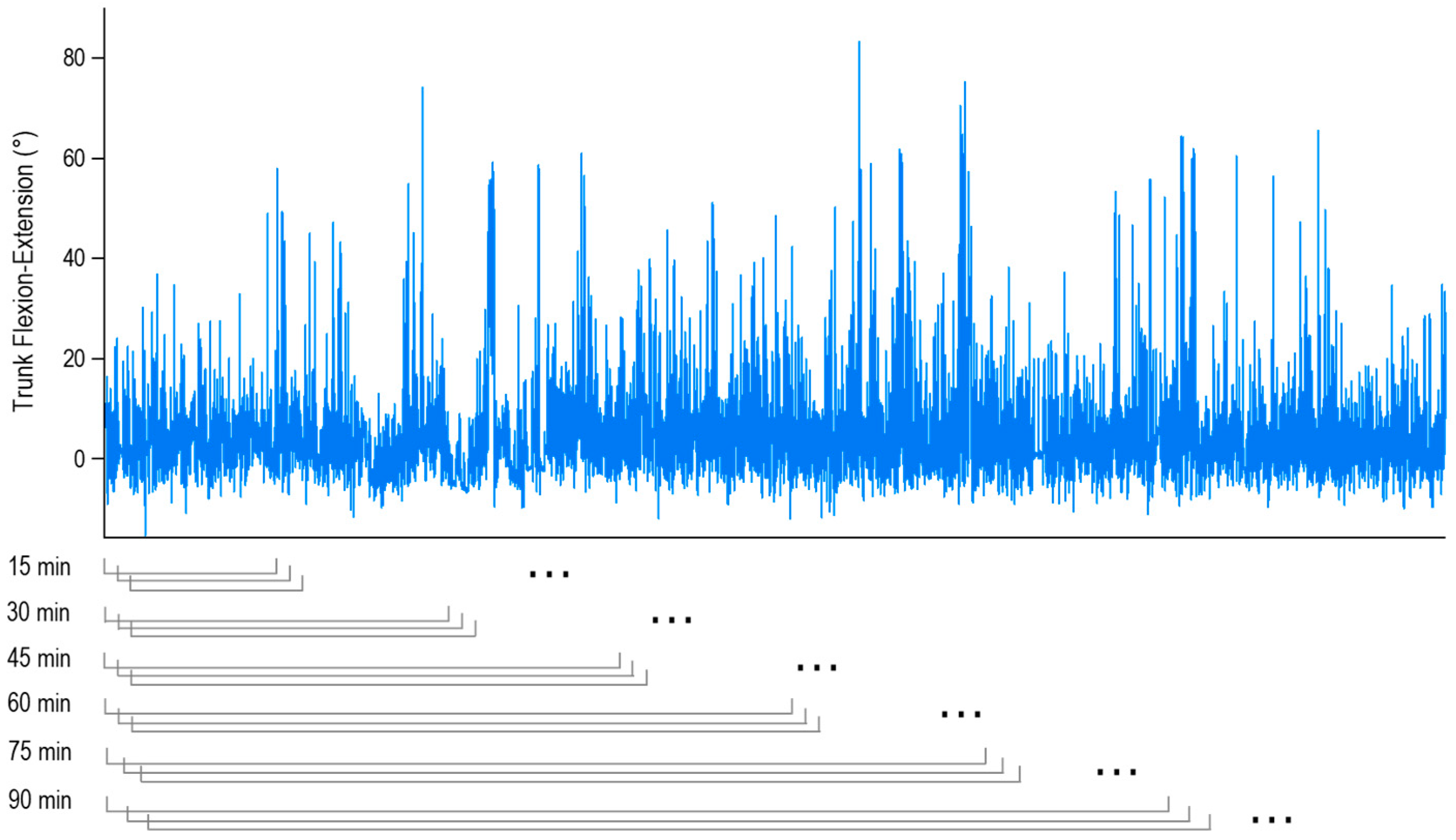
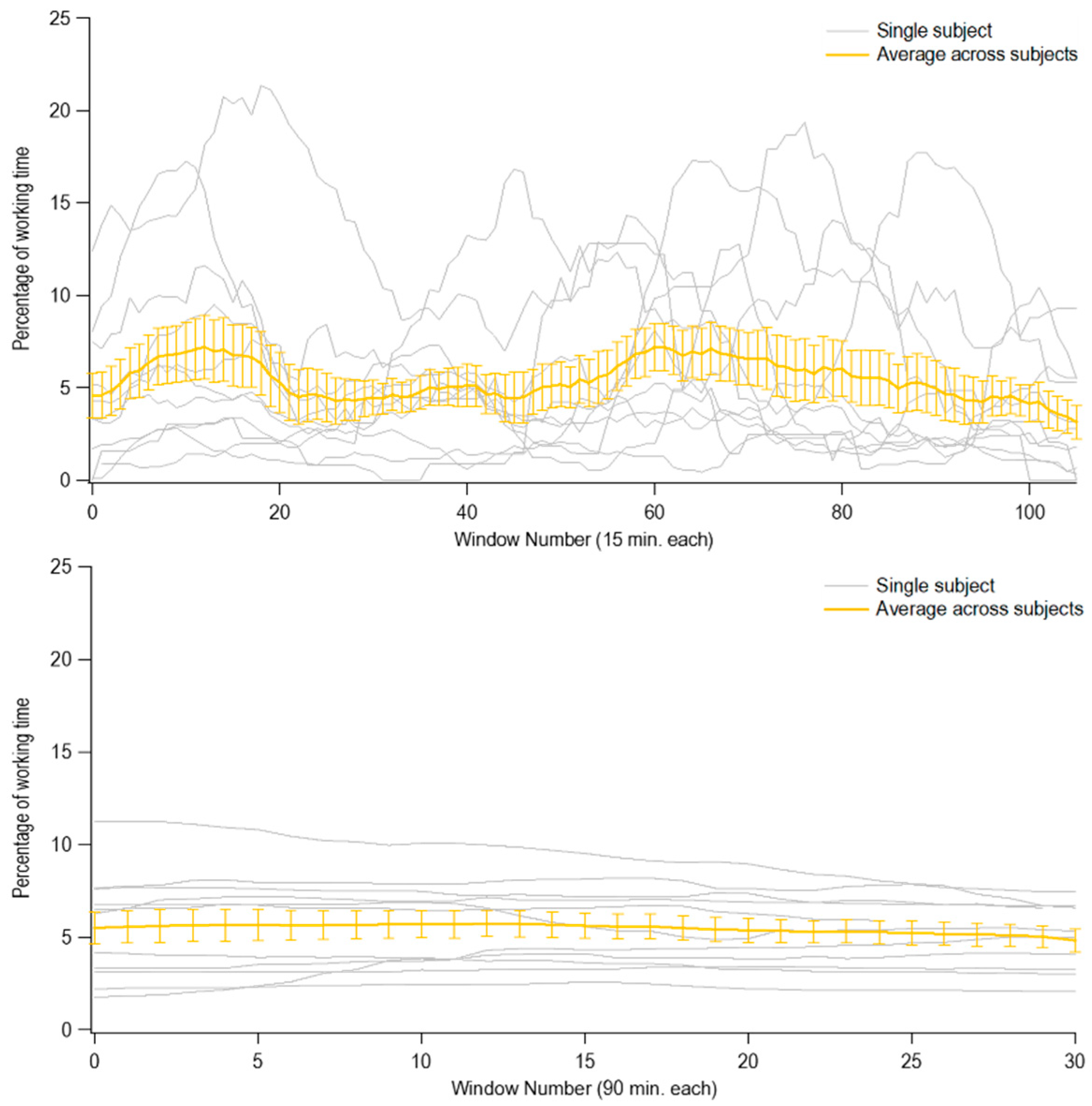
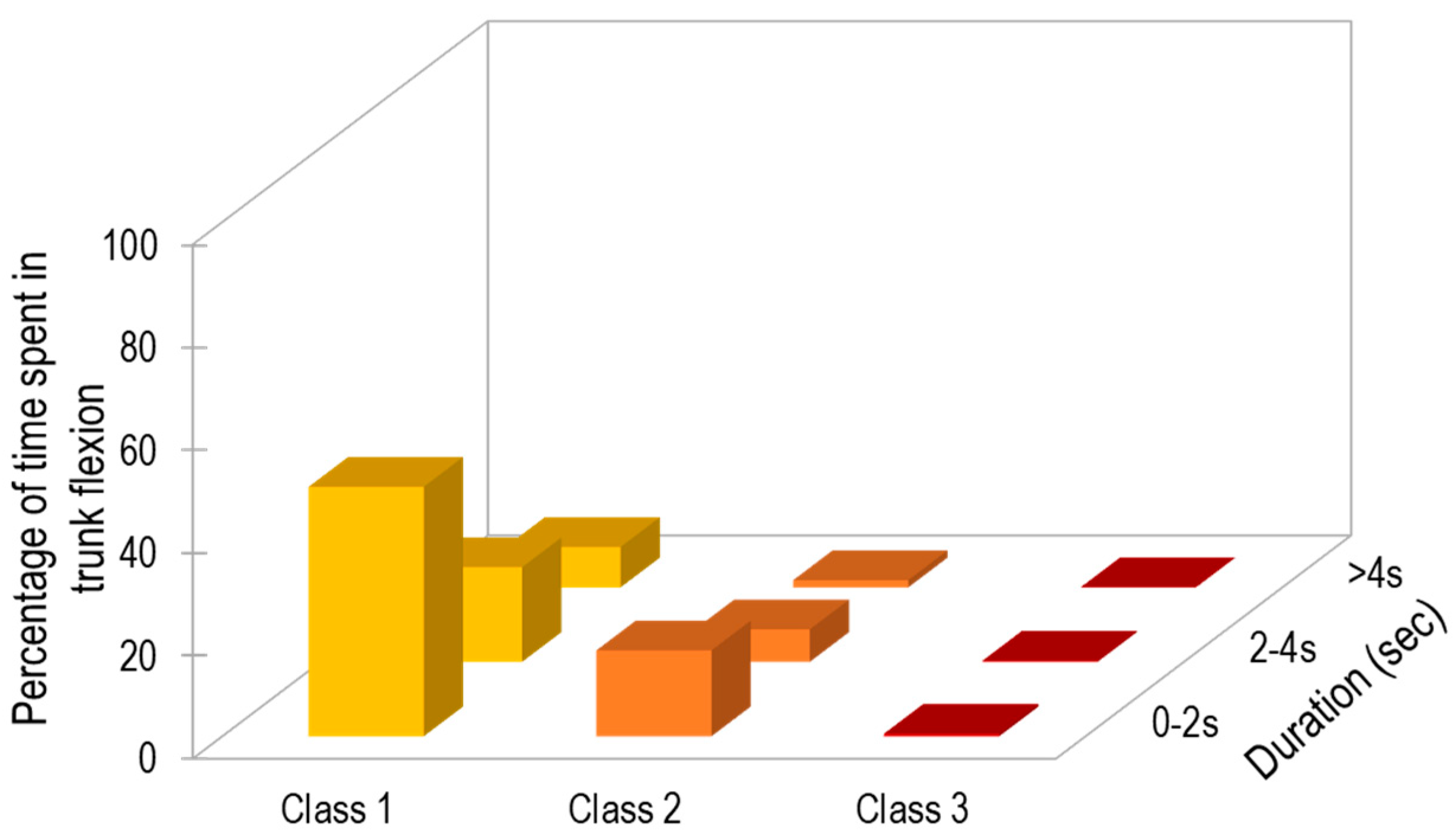
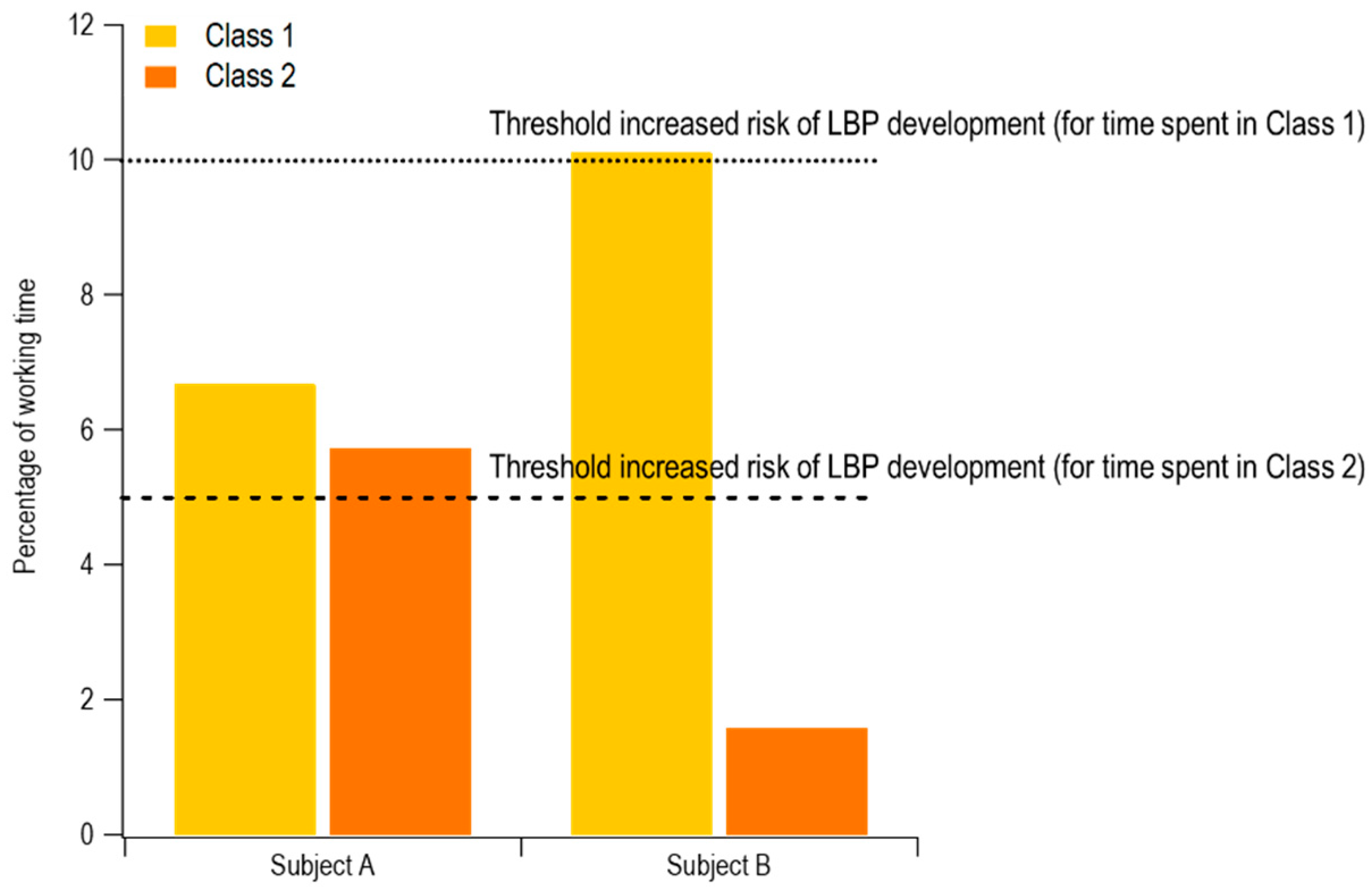
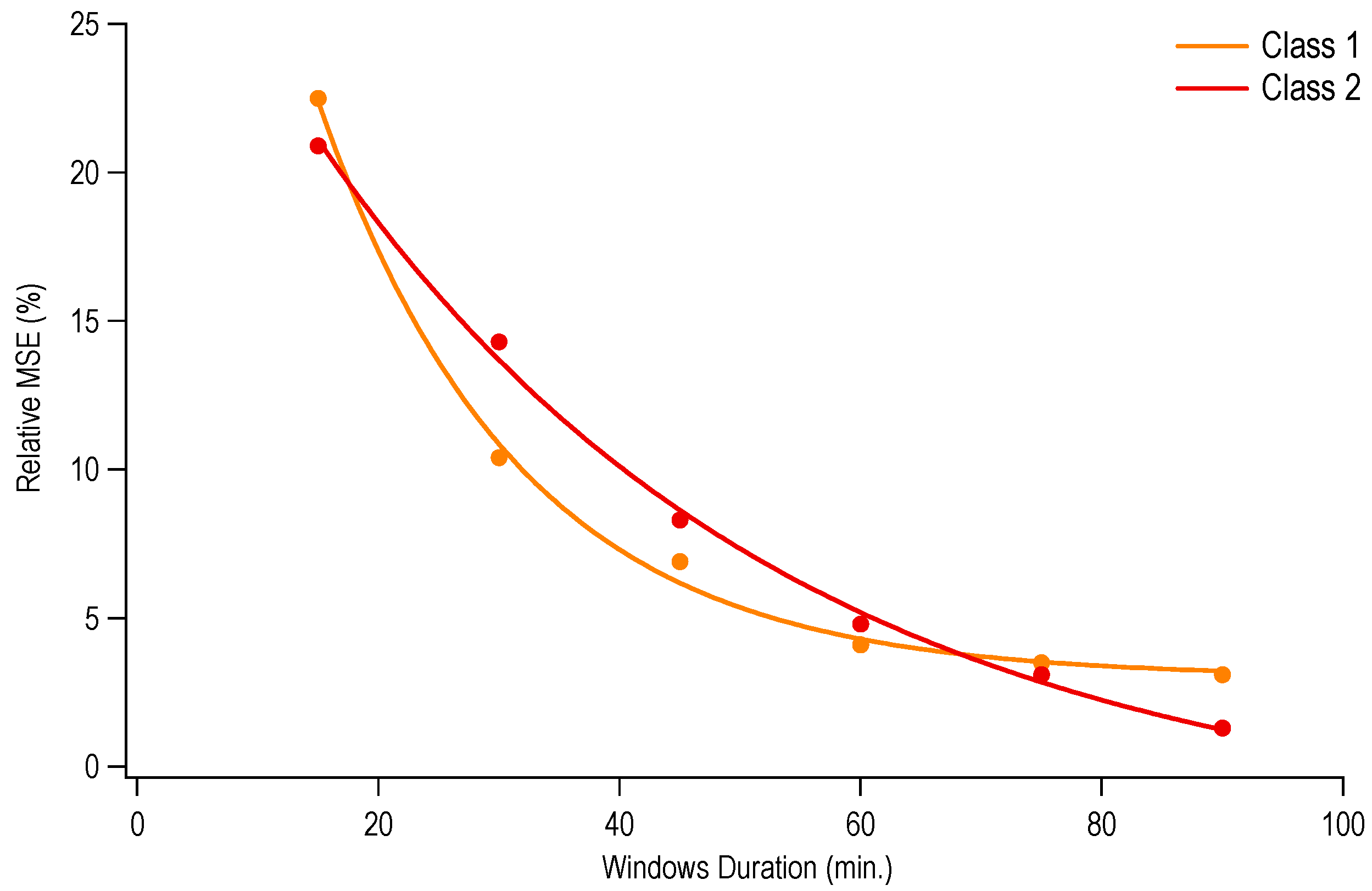
| Windows Duration | Class 1 (30–60°) | Class 2 (60–90°) | Class 3 (>90°) |
|---|---|---|---|
| Mean (SD) | Mean (SD) | Mean (SD) | |
| 2 h | 5.1 (2.2) | 2.3 (1.5) | negligible |
| 90 min | 5.3 (2.2) | 2.4 (1.6) | - |
| 75 min | 5.4 (2.4) | 2.5 (1.6) | - |
| 60 min | 5.3 (2.6) | 2.5 (1.8) | - |
| 45 min | 5.2 (3.0) | 2.5 (1.8) | - |
| 30 min | 5.3 (3.4) | 2.4 (2.0) | - |
| 15 min | 5.3 (4.2) | 2.4 (2.5) | - |
© 2020 by the authors. Licensee MDPI, Basel, Switzerland. This article is an open access article distributed under the terms and conditions of the Creative Commons Attribution (CC BY) license (http://creativecommons.org/licenses/by/4.0/).
Share and Cite
Porta, M.; Pau, M.; Orrù, P.F.; Nussbaum, M.A. Trunk Flexion Monitoring among Warehouse Workers Using a Single Inertial Sensor and the Influence of Different Sampling Durations. Int. J. Environ. Res. Public Health 2020, 17, 7117. https://doi.org/10.3390/ijerph17197117
Porta M, Pau M, Orrù PF, Nussbaum MA. Trunk Flexion Monitoring among Warehouse Workers Using a Single Inertial Sensor and the Influence of Different Sampling Durations. International Journal of Environmental Research and Public Health. 2020; 17(19):7117. https://doi.org/10.3390/ijerph17197117
Chicago/Turabian StylePorta, Micaela, Massimiliano Pau, Pier Francesco Orrù, and Maury A. Nussbaum. 2020. "Trunk Flexion Monitoring among Warehouse Workers Using a Single Inertial Sensor and the Influence of Different Sampling Durations" International Journal of Environmental Research and Public Health 17, no. 19: 7117. https://doi.org/10.3390/ijerph17197117
APA StylePorta, M., Pau, M., Orrù, P. F., & Nussbaum, M. A. (2020). Trunk Flexion Monitoring among Warehouse Workers Using a Single Inertial Sensor and the Influence of Different Sampling Durations. International Journal of Environmental Research and Public Health, 17(19), 7117. https://doi.org/10.3390/ijerph17197117







